The vision
Matariki is always a big event in the Māpua School calendar and in order that we truly celebrate this time each June, to reflect on the old year and welcome in the new, we have been building our knowledge and understanding of traditional Māori approaches and stories and developing our living landscape in response with the idea that we would be able to live some of the traditional values associated with Matariki.
Sowing the seeds for knowledge
5 years ago, we created the first school kūmara garden. We took a low key, ‘round the back of the classroom’ approach as a nature of science investigation. The kūmara slips (tipu) were donated by school whānau. The joy and engagement this created inspired a second year of planting and harvest and that too was successful. We were hooked on growing kūmara from here!
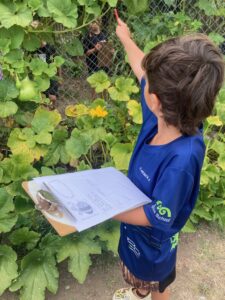
Observing, counting and collating data in the māra kai.
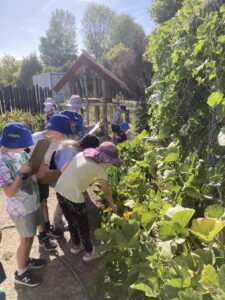
Checking the productivity and size.
In 2022 a māra rongoā garden was planted, inspired by a Middle Syndicate topic study on medicinal plants and the history of rongoā in Aotearoa. One group of tamariki also made miniature pātaka out of clay. Tamariki learnt about these traditional food storage houses and decided they wanted one to store their kūmara harvest in preparation for the school hangi.
In 2023 other cultural crops such as rīwai (Māori potato), hue and kamokamo were grown as was our knowledge around how to prepare and care for our gardens and a pātaka kai was built.
Empowered learners
The middle school students have been involved with each step from sprouting the tipu right through to harvest and storage. Growing the kūmara slips is particularly exciting, with students naming the large kūmara saved from previous harvest to grow the current tipu. ‘Poppa Joe’ grew sprouts so quickly, he had his tipu removed weekly and put into glass bottles of water to grow roots. ‘King Bob’ was a 1.5kg kūmara from the 2023 harvest and was saved, however in 2024 only 1 tiny tipu emerged but ‘yay! King Bob lives on!’
“I love this, I feel so happy when I’m in the garden.” – tamariki
Tending the tender tipu
The students have really enjoyed watching not only the kūmara but also the hue grow. Term 4 is when the garden beds are prepared by the students and the seedlings planted. There are always eager students willing to water and tend to the growing plants over the warm term.
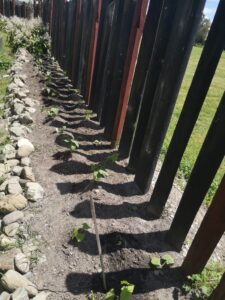
Hue planted along the fence line.
In term 1 students undertake pollination and bee statistical investigations – observing, counting and collating data in the māra rongoā and māra kai. Tamariki set up their own statistics investigation and learned how scientists collect data to explore questions and prove ideas. We used tally marks to count how many bees, bumblebees and moths we could see pollinating the kamokamo (squash) and hue (gourds).
In term 2 students use kawakawa leaves to make ‘fix anything balm’ that they sell at our Matariki market to raise money. We also make a kūmara bread sourdough starter which is baked and sold at the Matariki market too. In 2024 the money went to a local Christmas present charity.
The garden is also used to expand measurement skills, scientific and observational drawing and encouraged as a ‘peaceful place to relax’ at morning tea and lunchtimes.
Hands-on harvest
Students are also involved in the harvest, preparing and sharing cooked kūmara chips (with tomato sauce of course!)
Harvesting the kūmara has been a success each year, with 2023 offering a bumper harvest. Tamariki learn to harvest with care, using paint brushes to gently clean the soil away from the tubers. This is a great opportunity for teamwork.
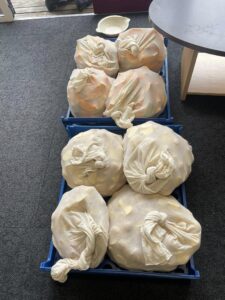
Kūmara and pumpkin prepared for the hangi at Matariki.
Developing the school hangi zone has been a great success. A hangi pit lined with bricks in collaboration with local clay artist Darryl Frost (Frost and Fire). The pit is multi-purpose and can be used to fire pottery too. Each year a team of hangi helpers (kapa haka students and whānau) help prep the veges, carve the meat, make up the servings, monitoring the fire and lifting the kai when it’s all cooked. Each year we have added more and more of our own produce grown in our māra kai. Kūmara is now the hero, and one of the hangi desserts was kamokamo brownie! kamokamo was also made into chutney to go with the hangi meal.
Along with preparing and sharing great kai, Māpua School has a cultural market and offers great entertainment from the schools kapa haka group and the annual Hiwa i te Rangi talent quest.
Each year tamariki make harakeke whetū to decorate a waka we raise towards the sky to conclude our Matariki celebrations.
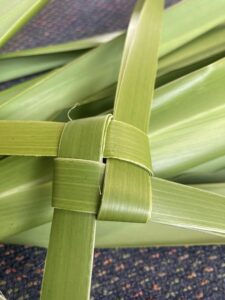
Creating harakeke whetū.
This year artists Sarah Trolle, Gordon and Tumanako Toi, Robin Slow, Amber Beech and Fran and Lauren Kidd painted/ decorated this year’s hue harvest, which were displayed at Matariki, and subsequently in the school library.
Learning together
Experts from the community has been part of the kumara growing journey and others have helped with the more practical side of things such as Māpua Landscapes who donated a soil mix and hue and kamokamo seeds donated by Shane from Crest Clean. Riwai seeds were donated by Mike Elkington (Ngāti Koata, Ngāti Kuia, Ngāti Toa Rangatira). Darryl Frost designed and built the hangi Pit. Cameron Trott – local organic horticulturalist and former chef who advises in the garden and leads the hangi process every year. Bob Bickerton visited in 2023 to share his taonga pūoru (Māori musical instruments) and this inspired Māpua to grow some hue themselves to make taonga pūoru or traditional water carriers. What generosity and rich contexts for learning!
“I can’t believe these were given to our school!” – exclaimed one student during harvest.
Resilience-building in action
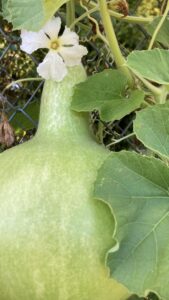
Hue gourd and flower flourishing.
In 2023 and 2024 the kumara harvest was divided 3 ways. A third is eaten and shared with the school community, a third is saved for seed stock, and a third stored and cooked in the Matariki Hangi.
The process of growing, harvesting and eating kai is an excellent all year-round learning opportunity. For some children it is the thing that fires them up to learn and gives them a reason to come to school. It is also a perfect opportunity to bring life to the Aotearoa NZ Histories curriculum.
Many of us learnt alongside each other on this journey, sharing what we knew, remembering or relearning and being open to the challenges. Now that many people in the community know about the māra rongoā and māra kai, we are being approached for advice and the sharing and trading of crops and knowledge. It’s not uncommon to strike up a chat outside the school fence that runs past the garden and before you know it you are trading plants of key ideas and knowledge about how to grow the plants.
Our enquiry has attracted mana whenua and community engagement and involvement and opened up opportunities. It has added depth and diversity to the culture of our kura.
Growing enough kūmara to prepare 300 meals for the Matariki festival and 250 desserts has been a challenge full of learning opportunities.
Curriculum integration
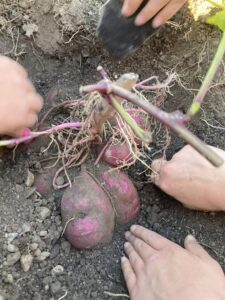
Careful harvest using traditional tools.
We have a kūmara maths sheet for tamariki to guess the weight of the kūmara, then take the actual weight, guess the length then take measurement for the actual length. Children then add up the harvest, work out averages, mean etc.
“Look at this one, it’s the hugest one I have ever seen!”
The Middles put their maths skills to the test straight away and used their developing measurement/scientific skills to draw labelled detailed drawings of the biggest kumara leaves they could find. They were amazed at the difference shade, sun, water, soil, and companion plants made to the kumara growth and health.
Art has been woven through several aspects of this broad enquiry – by sculpting pātaka, out of clay, hue work, etchings inspired by rongoā plant, and harakeke work. In 2021 Māpua won a science award (a microscope!) for its māra rongoā art entry!
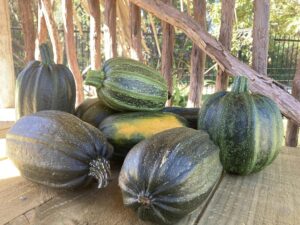
kamokamo harvested and stored in pātaka.
Science has been integrated through many experiences, observations and research – hue and kamokamo pollination, soil health, plant growth, photosynthesis, plant identification and the chemistry (the process (mixing, solid, liquids, heat, infusion, etc) of making the kawakawa balm.
Literacy has been advanced through writing the recipe for the kamokamo brownie listening to and retelling pūrākau about kūmara and other mana whenua histories.
NZ histories curriculum has been woven through learning about used pakohe (argillite stone particularly associated with Whakatū -Te tai o Aorere area) tools to dig and scratch the earth to reveal the rīwai/potatoes. They treated each potato like a tāonga/treasure.
This was what they said as they worked: “Oh my gosh this is so amazing!” and, “Did we really grow these?” followed by, “Can we grow even more next year?”
Our school culture of learning allows integration and provides a foundation for good things to happen We have an amazing principal and management team who support this holistic approach to learning through real life experiences.
“By being involved in a project like this I have developed a passion for growing indigenous crops. I think teachers with passions for a project or areas of the curriculum can easily spread their inspiration to tamariki with their enthusiasm and developing knowledge. It makes learning visible and real for the children and primary school children love hands on mahi!” – Heidi Trott, teacher, Māpua School
Banner image: On-going mahi taking place in the pātaka, māra rongoā and māra kai is part of school life.